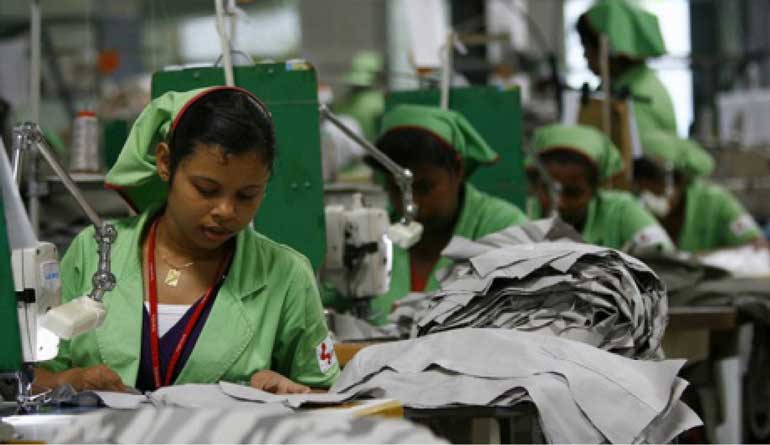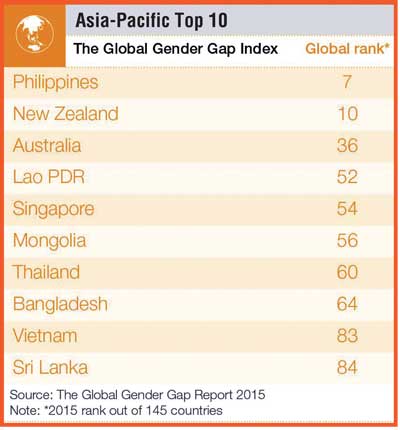Friday Nov 28, 2025
Friday Nov 28, 2025
Saturday, 21 November 2015 00:00 - - {{hitsCtrl.values.hits}}

Geneva: Sri Lanka’s gender gap increased over the last year and gender equality ranking declined from a 79 in 2014 to an 84 this year out of 145 countries, a report released Wednesday by the World Economic Forum showed.
The World Economic Forum Global Gender Gap Report 2015 showed that Sri Lanka has been slipping from its privileged position in the top 20 since 2010. Sri Lanka fell from closing 74.6% of the gender gap in 2010 to 68.6% this year.
The 10th annual edition of the Report ranks 145 countries on their ability to close the gender gap in four key areas: economic participation and opportunity, educational attainment, health and survival, and political empowerment.
Sri Lanka scored high in educational attainment and health and survival but the low score in political empowerment brought down the overall score.
Sri Lanka’s gender gap in education, and Health and Survival remains closed, ranking at first place in the key area.
In the educational attainment Sri Lanka ranked 57 among 145 countries closing the gender gap in in enrollment in primary to tertiary education. However, in literacy rate the gap was 2% with a female-to-male ratio of 0.98. The country ranked 69th in the Enrolment in Primary Education indicator.
Its high performance on the Wage equality for similar work indicator is offset by a low score on the Estimated earned income indicator. In the area of economic participation and opportunity Sri Lanka slipped 11 notches from last year scoring 0.577 with overall ranking at 120th place.
Very low scores on the Women in parliament and Women in ministerial positions indicators are offset by a high score on the Years with a female head of state indicator, with 21 years with a female head of state out of the last 50. In Political Empowerment Sri Lanka ranked 59th with a score of 0.193.
Nordic countries retained the top four spots they held last year, led by Iceland. Norway, Finland, Sweden, and Ireland followed in that order to hold the top five spots.
In Asia and the Pacific, the Philippines remains the region’s highest-ranked country at 7th, followed by New Zealand (10) and Australia (36). Sri Lanka rounded up the top ten at 10th place.
In South Asia, Bangladesh ranked at 64th, India improved to 108th from last year’s 114th, Nepal ranked 110th, Maldives at 113, Bhutan at 118, and Pakistan ranked in the bottom at 144th.
Top 10 most gender equal countries in Asia-Pacific
The Philippines tops the list of the most gender equal countries in Asia-Pacific, according to the World Economic Forum’s Global Gender Gap Reports 2015.
The report ranks 145 countries on their ability to tackle the gender gap and ensure women are not held back in four key areas: health and survival, education, politics and economic equality.
1. The Philippines (7th in global rankings) has made progress from last year and continues to rank among the top 10 in the overall index and first in the region with 79% of its gender gap closed. This can be explained by an increase on its Economic Participation and Opportunity score, which is due to more female legislators, senior officials and managers as well as professional and technical workers. It now ranks third-best in the region on this sub-index. Improvements have also been made on the Political Empowerment sub-index, due to more women in ministerial positions. The Health and Survival gender gap remains fully closed while the Educational Attainment gap, which had been fully closed since 2006, reopens slightly. Since 2006, the country has progressed across all categories except Educational Attainment, where it has slightly regressed.
2. New Zealand (10) similarly improves and moves up three places from last year, joining the top 10 in the overall Index with more than 78% of its gender gap closed. The country has also improved on Economic Participation and Opportunity, with better wage equality and more equal estimated earned income. Improvements have also been made on Political Empowerment, and the country now ranks third best in the region in this sub-index. Its Educational Attainment gender gap remains fully closed. Since 2006, the country has progressed across all categories except Health and Survival where it has slightly regressed.
3. Australia (36) follows and drops 12 places from 2014, with 73% of the gender gap now closed. This can be explained by a decrease in its Economic Participation and Opportunity score, due to a drop in estimated earned income. Since 2006, its Educational Attainment gender gap has remained fully closed. The country has shown progress across all sub-indexes except Health and Survival where it has slightly regressed.
4. Lao PDR (52) moves up eight places, closing 71% of its overall gender gap. The country has increased its Economic Participation and Opportunity score, with improvements to the Estimated Earned Income indicator score, and now ranks second best in the region on this sub-index. Its Educational Attainment score has also improved, due to higher literacy rates and more equal enrolment in secondary and tertiary education.
5. Singapore (54) moves up five places from last year due to improvements to its Economic Participation and Opportunity score, where it has increased wage equality for similar work and added more female legislators, senior officials and managers as well as professional and technical workers. The country now ranks first in the region on this sub-index. Yet on Educational Attainment and Political Empowerment it scores below the regional average. Singapore has made progress across all sub-indexes since 2006 and is the most improved country in the region on Economic Participation and Opportunity.
6. Mongolia (56) falls 12 spots from last year. The decrease can mainly be seen on the Political Empowerment score, with fewer women in ministerial positions (from 17% to 11%). The Health and Survival gender gap remains fully closed. When compared to 2006, the country has demonstrated improvements across all subindexes except Educational Attainment where it has regressed.
7. Thailand (60) moves down one place but slightly improves its overall score, due to an increase on the Economic Participation and Opportunity sub-index – in particular, more female legislators, senior officials and managers in the workforce. The country’s Health and Survival gender gap is fully closed. When compared to 2006, the country has shown progress across all sub-indexes except Political Empowerment, where it has regressed.
8. Bangladesh (64) moves up four places from 2014, showing improvement across all sub-indexes except Economic Participation and Opportunity. After a steady increase in score from 2006 to 2010, the country has regressed on this sub-index since 2013. Its Educational Attainment score continues to rise, due to higher literacy rates and enrolment in tertiary education. On the Health and Survival sub-index, the country ranks first in the region and, since 2006, is the second most-improved country in the world. Improvements have also been made on Political Empowerment, with more years with a female head of state; since 2006, it has been the second-most improved country of the region on this sub-index. Bangladesh is also the region’s second-most improved country on the overall index.
9. Vietnam (83) moves down seven places in the overall ranking. While its Economic Participation and Opportunity, Political Empowerment and Health and Survival scores have remained almost unchanged, its Educational Attainment score has decreased. This may be attributed to a decrease in female literacy rates.
10. Sri Lanka (84) drops five places; it has less wage equality for similar work and fewer female legislators, senior officials and managers. The country’s Political Empowerment performance has also regressed, with fewer years with a female head of state, even though there are now more women in ministerial positions. The Health and Survival gender gap is fully closed. Since 2006 the country is the region’s least improved country on the overall index, and the least improved in the world in the Political Empowerment sub-index.
The approval of the Cabinet of Ministers has been given to amend the Local Authorities (Special Provisions) Act No. 21 of 2012 in view of increasing the women’s representation in local authorities.
The proposal was submitted by Prime Minister Ranil Wickremesinghe to fulfill the pledge given at the recent presidential and general elections to allocate 25% of representation to women in provincial councils and local government institutions.